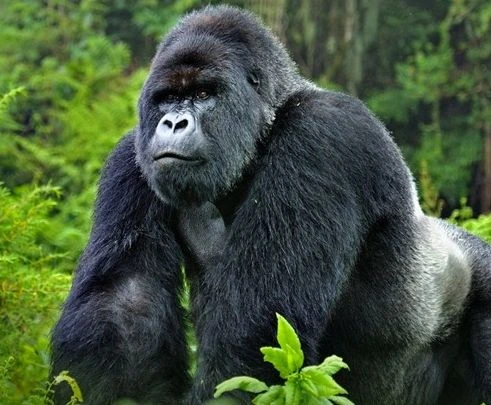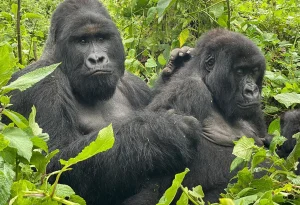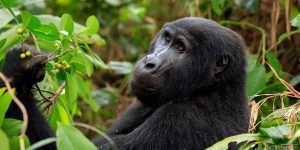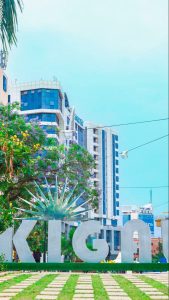Gorilla trekking in Rwanda ranks among the world’s most extraordinary wildlife encounters, drawing travelers eager to stand face-to-face with endangered mountain gorillas in their natural habitat. However, one detail often surprises visitors—the cost of a Rwanda gorilla trekking permit is $1,500 per person, making it the most expensive in East Africa. This premium price sparks curiosity among many travelers, especially when compared to Uganda’s $700 and the Democratic Republic of Congo’s $400 permits. Understanding why Rwanda charges more involves looking beyond the price tag to the country’s strategic tourism model, conservation priorities, and the high-quality experience it offers. In this guide, we explore the factors driving the cost, what the permit covers, and how your contribution directly supports the survival of these rare primates and the communities that live alongside them. Why Rwanda Gorilla Permits more expensive.
How Much Is a Gorilla Trekking Permit in Rwanda?
A gorilla trekking permit in Rwanda currently costs $1,500 per person for foreign non-residents. This fee is set by the Rwanda Development Board (RDB) and applies to all visitors who wish to trek and spend one hour with a habituated gorilla family in Volcanoes National Park. The cost is significantly higher than in neighboring countries—Uganda charges $700, and the Democratic Republic of Congo charges around $400.
Despite the higher price, Rwanda continues to attract travelers from around the world because of its premium gorilla trekking experience, efficient tourism infrastructure, and commitment to conservation. The permit fee not only grants access to the trek but also covers essential services, including expert guiding, ranger protection, and conservation funding. Why Rwanda Gorilla Permits more expensive.
Why Does Rwanda Charge $1,500 for a Gorilla Permit?
Rwanda’s government positions gorilla trekking as a high-value, low-impact tourism activity. The high cost serves multiple purposes:
- Premium Tourism Model: By setting a higher price, Rwanda targets travelers who can afford a luxury wildlife experience. This reduces visitor numbers, helping protect the gorillas’ habitat from overuse.
- Conservation Funding: The fee provides substantial resources for protecting gorillas and their environment.
- Economic Strategy: Rwanda has invested heavily in infrastructure, safety, and marketing to attract high-end eco-tourists who also contribute to other sectors of the economy.
- Sustainable Visitor Management: Limiting numbers through higher prices reduces environmental stress while ensuring that each visitor enjoys an exclusive and intimate wildlife encounter.
This pricing approach aligns with Rwanda’s broader strategy of promoting sustainable tourism while maintaining a strong conservation focus. Why Rwanda Gorilla Permits more expensive.
What Does the Cost of a Rwanda Gorilla Permit Cover?
The $1,500 gorilla trekking permit covers much more than just park entry:
- Guided Trekking Experience: Professional guides lead treks, offering insight into gorilla behavior, ecology, and conservation efforts.
- Ranger and Security Services: Armed rangers ensure the safety of both visitors and wildlife during the trek.
- Tracking Team Support: Skilled trackers locate gorilla families before the trek begins, increasing the likelihood of sightings.
- Conservation Programs: A significant portion of the fee funds anti-poaching patrols, habitat restoration, and gorilla health monitoring.
- Community Development: Revenue-sharing initiatives ensure that local communities benefit from gorilla tourism through schools, healthcare, and infrastructure projects.
By including these elements, the permit fee directly contributes to maintaining a safe, ethical, and well-managed trekking environment.
How Does Rwanda Use Gorilla Permit Fees?
Rwanda’s gorilla permit revenue is divided among several important initiatives:
- Conservation and Anti-Poaching Efforts: Funds pay for patrols, research, and veterinary care to protect the endangered mountain gorilla population.
- Community Revenue Sharing: The government allocates 10% of gorilla tourism revenue to local communities surrounding Volcanoes National Park. This supports health centers, schools, clean water projects, and small business grants.
- Park Management and Maintenance: Infrastructure improvements, trail maintenance, and visitor facilities are funded by tourism income.
- Training and Employment: Revenue supports training for guides, rangers, and community workers, ensuring high-quality service and job opportunities.
This reinvestment of tourism revenue strengthens conservation while improving the livelihoods of people living near gorilla habitats.
Is Gorilla Trekking in Rwanda Worth the Price?
Many travelers consider the experience worth the high cost because Rwanda offers a premium gorilla trekking environment. The country’s small size and excellent infrastructure make Volcanoes National Park easily accessible—just a two-hour drive from Kigali. This convenience reduces travel time and costs compared to destinations that require long road journeys or domestic flights.
Rwanda’s strict trekking regulations ensure minimal disturbance to the gorillas, while highly trained guides provide in-depth information during the trek. Visitors often describe the close-up encounter with mountain gorillas as a life-changing experience, making the permit price a worthwhile investment for wildlife enthusiasts and photographers.
How Does Rwanda’s Gorilla Trekking Compare to Uganda’s?
While both Rwanda and Uganda offer exceptional gorilla trekking experiences, there are notable differences:
- Cost: Rwanda’s permit costs $1,500, while Uganda’s is $700.
- Accessibility: Rwanda’s Volcanoes National Park is closer to the main airport, reducing transfer times. Uganda’s Bwindi Impenetrable Forest and Mgahinga Gorilla National Park require longer travel times from Entebbe or Kampala.
- Landscape: Rwanda’s treks take place on volcanic slopes with open bamboo forests, offering clearer views. Uganda’s treks are often in denser, more humid rainforest.
- Trekking Duration: Rwanda’s treks can be shorter on average due to the smaller size of the park and the proximity of gorilla families, though this is not guaranteed.
Choosing between the two often depends on budget, travel plans, and personal preference for landscape and accessibility.
How Many Gorilla Permits Are Available in Rwanda Per Day?
Rwanda issues a limited number of gorilla trekking permits each day to control visitor numbers and protect the gorillas. Each habituated gorilla family can be visited by only one group of up to eight tourists per day. With around 12 habituated families in Volcanoes National Park, this means approximately 96 permits are available daily.
This strict limit maintains a low-impact tourism model, allowing gorillas to live with minimal human disturbance while ensuring an intimate experience for visitors.
Does Rwanda Share Gorilla Permit Revenue with Communities?
Yes. Rwanda’s Revenue Sharing Program ensures that local communities receive 10% of gorilla tourism income. This initiative funds schools, health clinics, water projects, and small-scale enterprises in areas surrounding Volcanoes National Park.
By directly benefiting from tourism, communities have a strong incentive to protect gorillas and their habitat. This approach reduces human-wildlife conflict and promotes long-term conservation success.
Can Travelers Get Discounts on Rwanda Gorilla Permits?
Discounts on Rwanda gorilla permits are rare but may be available during specific promotional periods. In recent years, Rwanda has occasionally offered reduced permit prices to African citizens, East African Community residents, and conference delegates in Kigali. However, such discounts are temporary and not guaranteed annually.
Travelers should check with the Rwanda Development Board or authorized tour operators for current offers, as most visitors will pay the standard $1,500 fee.
When Is the Best Time to Go Gorilla Trekking in Rwanda?
The best time to trek gorillas in Rwanda is during the dry seasons: mid-December to early February and June to September. These months offer easier hiking conditions, with less mud and lower rainfall.
However, gorilla trekking is available year-round, and the rainy season can provide a lush, vibrant landscape with fewer tourists. Regardless of season, gorillas can be tracked successfully due to the expertise of Rwanda’s guides and trackers.
What Conservation Efforts Do Rwanda Gorilla Permit Fees Support?
Permit fees directly fund critical conservation programs, including:
- Monitoring gorilla health and behavior through veterinary teams.
- Expanding anti-poaching patrols to deter illegal hunting.
- Restoring degraded habitats to increase gorilla food sources.
- Supporting cross-border conservation initiatives with Uganda and the DRC.
- Funding scientific research on gorilla ecology and climate resilience.
These efforts have contributed to steady growth in the mountain gorilla population, a rare conservation success story for an endangered species.
How Do Travelers Book a Gorilla Permit in Rwanda?
Travelers can book gorilla permits through:
- The Rwanda Development Board (RDB): Official government channel for direct bookings.
- Licensed Tour Operators: Many safari companies include permit costs in all-inclusive packages that cover transport, guides, and accommodation.
Booking well in advance—often 6 to 12 months—is essential, especially during peak trekking seasons, as permits sell out quickly due to strict daily limits.
Conclusion
Why Rwanda Gorilla Permits more expensive. Rwanda’s gorilla permit price reflects its commitment to premium, sustainable tourism that benefits conservation and local communities. The $1,500 fee ensures fewer visitors, higher-quality experiences, and substantial funding for protecting mountain gorillas and their habitats.
By understanding how the permit system works and where the money goes, travelers can appreciate the value behind the cost. For those seeking an unforgettable wildlife encounter in a well-managed, conservation-focused environment, Rwanda’s gorilla trekking offers one of the most remarkable experiences in the world. Why Rwanda Gorilla Permits more expensive.




